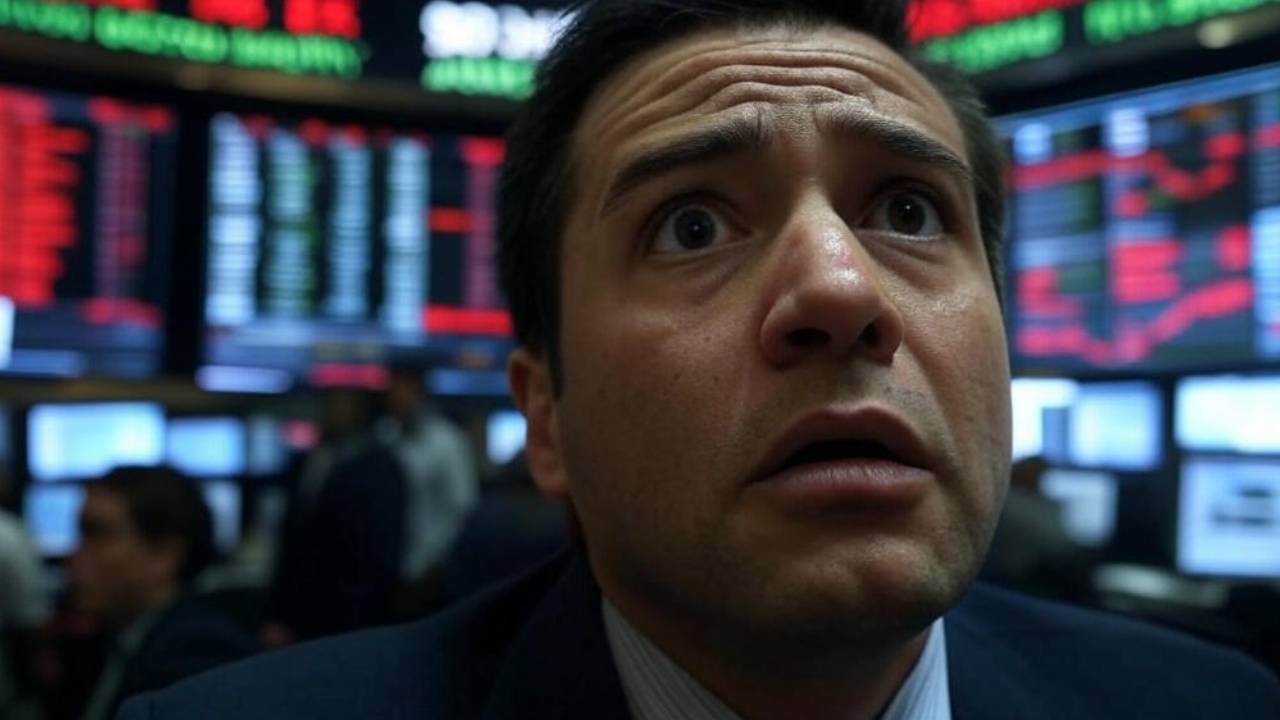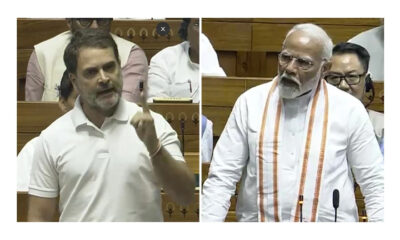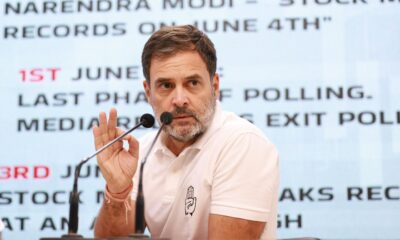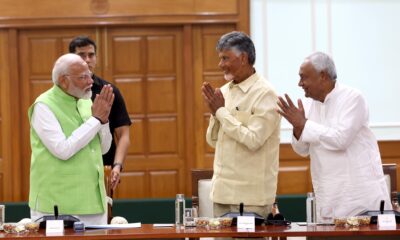india
Celebrating Progress: PM Modi Triumphantly Launches New Pamban Bridge in Tamil Nadu as CM Stalin Opts Out
On Sunday, April 6, 2025, Prime Minister Narendra Modi stood at the edge of Rameswaram, Tamil Nadu, to unveil a game-changer: the new Pamban Sea Bridge. This isn’t just any bridge—it’s India’s first vertical-lift railway sea bridge, a sleek, modern marvel linking the sacred island of Rameswaram to the mainland. With a wave of his […]
On Sunday, April 6, 2025, Prime Minister Narendra Modi stood at the edge of Rameswaram, Tamil Nadu, to unveil a game-changer: the new Pamban Sea Bridge. This isn’t just any bridge—it’s India’s first vertical-lift railway sea bridge, a sleek, modern marvel linking the sacred island of Rameswaram to the mainland. With a wave of his hand, Modi flagged off the first train, the Rameswaram-Tambaram (Chennai) express, chugging across the bridge, while a Coast Guard ship glided beneath its raised span. For the people of Tamil Nadu, it’s a moment of pride, a symbol of progress stitching together tradition and technology.
But the day wasn’t without its drama. Tamil Nadu Chief Minister M.K. Stalin was noticeably absent from the grand event. Instead of joining the celebrations, he chose to focus on a different mission, raising eyebrows and sparking conversations across the state.
Why Stalin Skipped the Big Reveal
Stalin didn’t just miss the event by chance—he had a point to make. While Modi was busy cutting ribbons in Rameswaram, the CM was miles away, delivering a speech in Ooty at the opening of a new 700-bed hospital. But it wasn’t just a scheduling conflict. Stalin used the moment to press a bigger issue: delimitation. He’s been vocal about his concerns, urging Modi to promise Tamil Nadu that its share of parliamentary seats won’t shrink under the proposed redistricting plan. For Stalin, it’s about fairness—states like Tamil Nadu, which have worked hard to manage population growth, shouldn’t lose out, he argues.
“I’ve already told the PM I couldn’t make it due to prior commitments,” Stalin later explained, brushing off any speculation of a snub. Yet, his absence spoke louder than words, turning a day of celebration into a subtle political standoff.
A Warm Welcome and a Bridge to the Future
Modi didn’t arrive alone. Fresh from a trip to Sri Lanka, he was greeted with open arms by Tamil Nadu Governor R.N. Ravi, Finance Minister Thangam Thenarasu, and a lineup of BJP heavyweights like L. Murugan and K. Annamalai. The mood was festive, with the crowd buzzing about the bridge’s promise: faster trains, smoother travel, and a lifeline for Rameswaram’s pilgrims and residents.
Spanning 2.07 kilometers across the Palk Strait, the new Pamban Bridge replaces an aging icon from 1914. At a cost of over ₹550 crore, it’s built to last, with a vertical lift that rises 17 meters to let ships pass—a feat of engineering that’s got everyone talking. For locals, it’s more than steel and concrete; it’s a connection to the world beyond the waves.
What’s Next for Tamil Nadu?
As the train rolled out and the ship sailed through, Modi’s visit underscored a vision of growth. But with Stalin’s absence and his delimitation demands hanging in the air, the day left a lingering question: can progress on the ground bridge the political divides above it? For now, Tamil Nadu’s newest landmark stands tall, ready to carry its people into the future—one train ride at a time.
india
Cooking Gas Prices Set to Rise by Rs 50 Per Cylinder: What It Means for You
Starting April 8, 2025, cooking gas prices in India are going up by Rs 50 per cylinder, as announced by Union Oil Minister Hardeep Singh Puri on Monday. This price hike, rolled out by distribution companies, affects everyone—whether you’re a general user or part of the Ujjwala scheme. For the average household, this means a […]

Starting April 8, 2025, cooking gas prices in India are going up by Rs 50 per cylinder, as announced by Union Oil Minister Hardeep Singh Puri on Monday. This price hike, rolled out by distribution companies, affects everyone—whether you’re a general user or part of the Ujjwala scheme. For the average household, this means a 14.2-kg LPG cylinder will now cost Rs 853, up from Rs 803. Meanwhile, Ujjwala beneficiaries will see their subsidized rate jump from Rs 503 to Rs 553.
Why the Increase?
The minister explained that this adjustment comes after public sector oil companies faced massive losses—over Rs 41,338 crore in the fiscal year ending March 31, 2025—due to selling LPG below cost. With international oil prices fluctuating, the actual cost of a 14.2-kg cylinder in Delhi should be Rs 1,028.50. However, companies have been keeping prices lower to ease the burden on consumers, leading to what’s called “under-recoveries.” Now, with losses piling up, this moderate hike aims to cover future costs, while the Oil Ministry plans to seek extra budget support to offset past deficits.
How Cooking Gas Prices Impacts Your Wallet
For Ujjwala households, cooking with LPG will now cost about Rs 6.10 per day, while general users will pay around Rs 14.58 daily. Puri called these rates “reasonable,” noting that prices will be reviewed monthly. If global oil prices drop, consumers could see some relief down the line. Alongside this, the government has also raised excise duties on petrol and diesel by Rs 2 per liter each, though retail pump prices won’t change for now—oil companies will absorb this hit thanks to lower international crude costs.
A Balancing Act
This isn’t just about numbers—it’s about keeping kitchens running affordably while managing a complex energy market. The Rs 50 hike might sting a little, especially for budget-conscious families, but it’s a step to stabilize the system. For now, oil companies are bearing the brunt of past losses, and the additional revenue from fuel duties might help them recover.
Stay tuned for monthly updates on LPG rates, and let’s hope softer global prices bring some good news soon! For the latest on cooking gas prices and how they affect your household, keep checking back here.
india
Massive Indian Markets Crash in 10 Seconds, Wiping Out ₹20 Lakh Crore Amid Trump Tariff Shock
Nifty Dives 1,000 Points Amid Global Trade War Fears—What’s Next for India’s Economy? On April 7, 2025, India’s stock market took a brutal hit, leaving investors reeling. The BSE Sensex nosedived by more than 2,500 points, while the NSE Nifty plummeted over 1,000 points in early trading. This dramatic drop wiped out a staggering Rs. […]

Nifty Dives 1,000 Points Amid Global Trade War Fears—What’s Next for India’s Market?
On April 7, 2025, India’s stock market took a brutal hit, leaving investors reeling. The BSE Sensex nosedived by more than 2,500 points, while the NSE Nifty plummeted over 1,000 points in early trading. This dramatic drop wiped out a staggering Rs. 20 lakh crore in investor wealth in mere seconds, all triggered by escalating fears over U.S. President Donald Trump’s aggressive tariff policies.
The chaos began after Trump rolled out hefty reciprocal tariffs on April 2, targeting around 60 countries. India faced a 26% tariff hike, while China got slapped with a whopping 54%. Not to be outdone, China fired back with a 34% tariff on the U.S., igniting panic about a full-blown global trade war. The ripple effect was swift—Asian markets tanked, U.S. futures signaled more pain ahead, and India’s financial hubs felt the heat.
By midday, the Sensex was down over 3,000 points, hovering around 72,000, with the Nifty slipping below 22,000. The Indian rupee weakened too, dropping 30 paise to 85.74 against the dollar. Experts point to Trump’s tariffs as the main culprit, warning that this could be just the beginning. “India’s getting caught in the crossfire of global trade tensions,” said market analyst Ajay Bagga. “We’re not crashing because of our own mess—it’s the world’s mess spilling over. India needs bold fiscal moves to shield itself from this storm.”
The fallout wasn’t limited to India. Wall Street’s futures hinted at a rough Monday ahead, while Japan and Taiwan saw trading halts as their markets spiraled. Back home, every major sector—auto, IT, pharma, you name it—was bleeding red. Not a single BSE Sensex stock escaped the carnage.
Analysts are sounding the alarm: if this tariff showdown drags on, India’s economy could face serious headwinds. “The Nifty’s already broken key support levels,” noted SEBI-registered analyst Sunil Gurjar. “If it keeps sliding, we’re looking at a deeper downturn.” Meanwhile, some experts see a silver lining, suggesting India might need a hefty reform package to weather this “global economic winter.”
As Trump digs in his heels—calling tariffs “necessary medicine” for trade imbalances—the world’s markets are left scrambling. For Indian investors, it’s a tense wait-and-see game. Will the government step in with a rescue plan, or is this just the start of a wild ride? Stay tuned as this story unfolds.
Business
Shocking Stock Market Crash: Sensex Plummets 2,700 Points Amid Global Turmoil
Why Indian Stock Market Are Reeling and What It Means for Investors

Why Indian Stock Market Are Reeling and What It Means for Investors
The Indian stock market took a brutal hit on April 7, 2025, as the BSE Sensex nosedived by a staggering 2,700 points, closing at 79,260.36 after an intraday drop of 3,251.09 points. The NSE Nifty wasn’t spared either, tumbling 788.45 points to settle at 24,219.35. Investors watched in dismay as over Rs 10 lakh crore in market wealth evaporated in a single day, marking one of the steepest declines in recent memory.
So, what sparked this chaos? Analysts point to a perfect storm of global and domestic pressures. The trigger came from across the Atlantic, where U.S. President Donald Trump’s aggressive tariff threats against Mexico, Canada, and China—set to kick in on March 4—sent shockwaves through global markets. Indian stocks, already wobbly after five straight months of losses (a streak unseen since 1996), buckled under the weight of this news. Foreign institutional investors (FIIs) have been dumping Indian equities to the tune of $25 billion since October, amplifying the panic.
The bloodbath hit hardest in key sectors: IT stocks cratered 4%, autos skidded 3.7%, PSU banks dropped 3.2%, and consumer stocks fell 3%. Mid- and small-cap companies weren’t immune, each shedding over 2.5%. Among the Sensex heavyweights, Reliance Industries, HDFC Bank, and Infosys led the plunge, while a few resilient players like Sun Pharma and Hindustan Unilever managed to stay afloat.
Market watchers aren’t sugarcoating it—this could get worse before it gets better. Experts like Anil Rego from Right Horizons warn that jittery global conditions might push markets even lower. “The U.S. tariff fallout is rattling investor confidence worldwide, and India’s not insulated,” he said. Ambareesh Baliga, an independent analyst, echoed the sentiment, noting that the relentless FII sell-off and Trump’s “tariff tantrums” could keep the downward spiral spinning.
Adding fuel to the fire, the Indian rupee hit a record low of 86.61 against the U.S. dollar, its sharpest single-day drop in nearly two years. Rising U.S. bond yields and fears of a slowing American economy only deepened the gloom. Deepak Jasani of HDFC Securities highlighted domestic woes too: “High valuations and stretched investor expectations were a ticking time bomb waiting for a global cue like this.”
For everyday investors, the scene feels like a rollercoaster with no brakes. After a record-breaking rally that saw the Sensex peak at 85,978.25 in late 2024, this crash has wiped out gains and left portfolios bleeding. Social media is buzzing with reactions—some traders are calling it a “buying opportunity,” while others lament the timing, urging caution until the dust settles.
What’s next? Analysts suggest buckling up for more volatility. With Trump’s policies looming large and FIIs showing no signs of slowing their exodus, the road ahead looks bumpy. Yet, there’s a sliver of hope—seasoned investors might find bargains in this chaos, provided they’ve got the stomach for risk. For now, though, India’s stock market is nursing its wounds, and the world’s eyes are on how it’ll weather this storm.
-

 india2 years ago
india2 years ago“Major Crash of Sukhoi Su-30 and Mirage 2000 Fighter Jets in Madhya Pradesh”
-

 Sports2 years ago
Sports2 years agoWFI meetings on April 16, elections likely to be discussed
-

 india1 year ago
india1 year agoPM Modi Meets Deve Gowda for Seat Sharing Talks
-

 india1 year ago
india1 year agoBengaluru: False threat to bomb Raj Bhavan
-

 india2 years ago
india2 years ago“AIMIM to Contest 50 Seats in Upcoming Telangana Assembly Elections”
-

 Entertainment1 year ago
Entertainment1 year agoAnant Ambani: Controversy at the Ambani Pre-Wedding Bash
-

 Entertainment2 years ago
Entertainment2 years agoRajinikanth is Moideen Bhai in ‘Lal Salaam’
-

 Videos2 years ago
Videos2 years agoBidar News : Press Meet Organized By Zilla Kannada Sahitya Parishad















